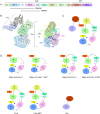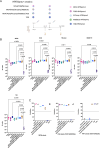Structure-guided design of VAR2CSA-based immunogens and a cocktail strategy for a placental malaria vaccine
- PMID: 38437239
- PMCID: PMC10939253
- DOI: 10.1371/journal.ppat.1011879
Structure-guided design of VAR2CSA-based immunogens and a cocktail strategy for a placental malaria vaccine
Abstract
Placental accumulation of Plasmodium falciparum infected erythrocytes results in maternal anemia, low birth weight, and pregnancy loss. The parasite protein VAR2CSA facilitates the accumulation of infected erythrocytes in the placenta through interaction with the host receptor chondroitin sulfate A (CSA). Antibodies that prevent the VAR2CSA-CSA interaction correlate with protection from placental malaria, and VAR2CSA is a high-priority placental malaria vaccine antigen. Here, structure-guided design leveraging the full-length structures of VAR2CSA produced a stable immunogen that retains the critical conserved functional elements of VAR2CSA. The design expressed with a six-fold greater yield than the full-length protein and elicited antibodies that prevent adhesion of infected erythrocytes to CSA. The reduced size and adaptability of the designed immunogen enable efficient production of multiple variants of VAR2CSA for use in a cocktail vaccination strategy to increase the breadth of protection. These designs form strong foundations for the development of potent broadly protective placental malaria vaccines.
Copyright: This is an open access article, free of all copyright, and may be freely reproduced, distributed, transmitted, modified, built upon, or otherwise used by anyone for any lawful purpose. The work is made available under the Creative Commons CC0 public domain dedication.
Conflict of interest statement
NHT, RM and PED are inventors on a patent application related to this work. JYAD is an inventor on patent US9855321B2.
Figures





Similar articles
-
A single full-length VAR2CSA ectodomain variant purifies broadly neutralizing antibodies against placental malaria isolates.Elife. 2022 Feb 1;11:e76264. doi: 10.7554/eLife.76264. Elife. 2022. PMID: 35103596 Free PMC article.
-
A conformational epitope in placental malaria vaccine antigen VAR2CSA: What does it teach us?PLoS Pathog. 2023 May 25;19(5):e1011370. doi: 10.1371/journal.ppat.1011370. eCollection 2023 May. PLoS Pathog. 2023. PMID: 37228009 Free PMC article.
-
Antibodies to a full-length VAR2CSA immunogen are broadly strain-transcendent but do not cross-inhibit different placental-type parasite isolates.PLoS One. 2011 Feb 7;6(2):e16622. doi: 10.1371/journal.pone.0016622. PLoS One. 2011. PMID: 21326877 Free PMC article.
-
Designing a VAR2CSA-based vaccine to prevent placental malaria.Vaccine. 2015 Dec 22;33(52):7483-8. doi: 10.1016/j.vaccine.2015.10.011. Epub 2015 Nov 26. Vaccine. 2015. PMID: 26469717 Free PMC article. Review.
-
Progress and Insights Toward an Effective Placental Malaria Vaccine.Front Immunol. 2021 Feb 25;12:634508. doi: 10.3389/fimmu.2021.634508. eCollection 2021. Front Immunol. 2021. PMID: 33717176 Free PMC article. Review.
Cited by
-
Structure-based design of a Plasmodium vivax Duffy-binding protein immunogen focuses the antibody response to functional epitopes.Protein Sci. 2024 Aug;33(8):e5095. doi: 10.1002/pro.5095. Protein Sci. 2024. PMID: 38988315 Free PMC article.
-
RBD design increases the functional antibody titers elicited by SARS-CoV-2 spike vaccination.Antiviral Res. 2024 Aug;228:105937. doi: 10.1016/j.antiviral.2024.105937. Epub 2024 Jun 18. Antiviral Res. 2024. PMID: 38901738 Free PMC article.
-
Exploring the P. falciparum antigens associated with reduced risk of malaria in pregnancy.Front Immunol. 2025 Jul 14;16:1622435. doi: 10.3389/fimmu.2025.1622435. eCollection 2025. Front Immunol. 2025. PMID: 40726979 Free PMC article.
References
MeSH terms
Substances
LinkOut - more resources
Full Text Sources
Medical

